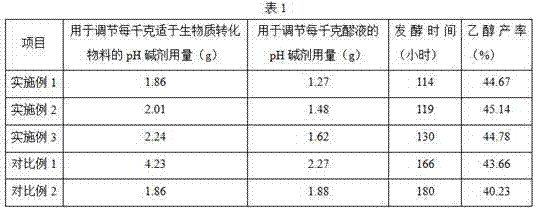Preparation method of cellulosic ethanol
A technology of cellulosic ethanol and cellulose, applied in the field of preparation of cellulosic ethanol, can solve the problems of incomparability and high cost of cellulosic ethanol, and achieve the effects of reducing preparation cost, reducing control difficulty and reducing load
- Summary
- Abstract
- Description
- Claims
- Application Information
AI Technical Summary
Problems solved by technology
Method used
Image
Examples
Embodiment 1
[0040] Crush the banana stalks into 5mm lengths and mix them evenly with the acid solution. With natural pH, blast at 190°C for 10 minutes for acidification blasting, so as to obtain materials that are initially degraded and suitable for biomass conversion. Mix 65°Bx with materials that are initially degraded and suitable for biomass conversion and adjust the pH to 3.5, then add enzymes and mix evenly, and enzymatically hydrolyze at 60°C for 50 hours to obtain mash. Adjust the pH of the mash to 4, add yeast that can use xylose to ferment ethanol for fermentation, ferment until the 10th hour, add Trichoderma reesei, ferment until the 16th hour, add Saccharomyces cerevisiae, and continue to ferment for 48 hours, A cellulosic ethanol-containing feed is obtained from which ethanol is isolated. The amount of yeast, Trichoderma reesei, and Saccharomyces cerevisiae that can ferment ethanol from xylose is 5% of the substrate mass. The results are shown in Table 1.
Embodiment 2
[0042] Crush the banana stalks into 10mm lengths and mix them evenly with the acid solution. With a natural pH, blast at 210°C for 7 minutes for acid blasting, so as to obtain materials that are initially degraded and suitable for biomass conversion. Mix 42°Bx with materials that are initially degraded and suitable for biomass conversion and adjust the pH to 4.0, then add enzymes and mix evenly, and enzymatically hydrolyze at 47°C for 67 hours to obtain mash. Adjust the pH of the mash to 4.5, add yeast that can use xylose to ferment ethanol for fermentation, and ferment until the 6th hour, add Trichoderma reesei, ferment until the 12th hour, add Saccharomyces cerevisiae, and continue to ferment for 40 hours, A cellulosic ethanol-containing feed is obtained from which ethanol is isolated. The amount of yeast, Trichoderma reesei and Saccharomyces cerevisiae that can ferment ethanol from xylose is 10% of the substrate mass. The results are shown in Table 1.
Embodiment 3
[0044] Crush the banana stalks into 25mm lengths and mix them evenly with the acid solution. With natural pH, blast at 250°C for 3 minutes for acidification blasting, so as to obtain materials that are initially degraded and suitable for biomass conversion. Mix the 35°Bx with the materials that are initially degraded and suitable for biomass conversion and adjust the pH to 4.5, then add enzymes and mix evenly, and enzymatically hydrolyze at 40°C for 90 hours to obtain mash. Adjust the pH of the mash to 5, add yeast that can use xylose to ferment ethanol for fermentation, and ferment until the 6th hour, add Trichoderma reesei, ferment to the 10th hour, add Saccharomyces cerevisiae, and continue to ferment for 30 hours, A cellulosic ethanol-containing feed is obtained from which ethanol is isolated. The amount of yeast, Trichoderma reesei and Saccharomyces cerevisiae that can ferment ethanol from xylose is 12% of the substrate mass. The results are shown in Table 1.
PUM
 Login to View More
Login to View More Abstract
Description
Claims
Application Information
 Login to View More
Login to View More - R&D
- Intellectual Property
- Life Sciences
- Materials
- Tech Scout
- Unparalleled Data Quality
- Higher Quality Content
- 60% Fewer Hallucinations
Browse by: Latest US Patents, China's latest patents, Technical Efficacy Thesaurus, Application Domain, Technology Topic, Popular Technical Reports.
© 2025 PatSnap. All rights reserved.Legal|Privacy policy|Modern Slavery Act Transparency Statement|Sitemap|About US| Contact US: help@patsnap.com

